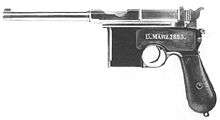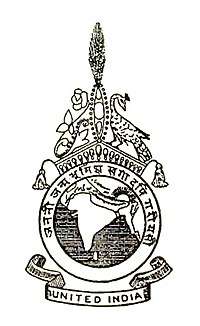Kakori conspiracy
The Kakori Conspiracy (or Kakori train robbery or Kakori Case) was a train robbery that took place between Kakori and, near Lucknow, on 9 August 1925 during the Indian Independence Movement against the British Indian Government. The robbery was organised by Hindustan Republican Association (HRA).
The robbery was conceived by Ram Prasad Bismil and Ashfaqullah Khan who belonged to the HRA, which later became the Hindustan Socialist Republican Association. This organisation was established to carry out revolutionary activities against the British Empire in India with the objective of achieving independence. Since the organisation needed money for purchase of weaponry, Bismil and his party decided to plunder a train on one of the Northern Railway lines.[1] The robbery plan was executed by Ram Prasad Bismil, Ashfaqulla Khan, Rajendra Lahiri, Chandrashekhar Azad, Sachindra Bakshi, Keshab Chakravarty, Manmathnath Gupta, Mukundi Lal (Mukundi Lal Gupta), Banwari Lal , Kundan Lal, and Pranawesh Mukherjee .[2][3] One passenger was killed unintentionally.
Robbery
On 9 August 1925, the Number 8 Down Train travelling from Shahjahanpur to Lucknow [4] was approaching the town of Kakori (now in Uttar Pradesh), when one of the revolutionaries pulled the emergency chain to stop the train and subsequently overpowered the guard. It is believed that they looted that specific train because it was supposedly carrying the money bags which allegedly belonged to the Indians and was being transferred to the British government treasury. They looted only these bags (which were present in the guards' cabin and contained more than 100,000 rupees) and escaped to Lucknow. The objectives of this robbery were to :
- Fund the HRA with funds stolen from the British administration.
- Garner public attention by creating a positive image of the HRA among Indians.
One passenger, Ahmed Ali was killed in an unintentional discharge, but this made it a manslaughter case. Following the incident, the British administration started an intense manhunt and arrested several of the revolutionaries who were members or part of the HRA. Their leader, Ram Prasad Bismil, was arrested at Saharanpur on 26 September 1925, and his lieutenant, Ashfaqullah Khan, was arrested ten months later at Delhi.
Arrests
Forty people[5] were arrested from all over India. Their names (with the place of arrest) are:
- From Agra
- Chandra Dhar Johri
- Chandra bhal Johri
- From Allahabad
- Shitala Sahai
- Jyoti Shankar Dixit
- Bhupendra Nath Sanyal
- From Banaras
- Manmathnath Gupta
- Phanindra Nath Banerji
- Damodar Swarup Seth
- Ram Nath Pandey
- Dev Datt Bhattacharya
- Indra Vikram Singh
- Mukundi Lal
- From Bengal
- Sachindra Nath Sanyal
- Jogesh Chandra Chatterjee
- Rajendra Lahiri
- Sharat Chandra Guha
- Kali Das Bose
- From Etah
- Babu Ram Verma
- From Hardoi
- Bhairon Singh
- From Kanpur
- Ram Dulare Trivedi
- Gopi Mohan
- Raj Kumar Sinha
- Suresh Chandra Bhattacharya
- From Lahore
- Mohan Lal Gautam
- From Lakhimpur
- Harnam Sundarlal
- From Lucknow
- Govind Charan Kar
- Shachindra Nath Vishvas
- From Mathura
- Shiv Charan Lal Sharma (warrant was issued against him but he was not arrested because he fled to Pondicherry)
- From Meerut
- Vishnu Sharan Dublish
- From Orai
- Veer Bhadra Tiwari
- From Pune
- Ram Krishna Khatri
- From Raibareli
- Banwari Lal
- From Shahjahanpur
- Ram Prasad Bismil
- Banarsi Lal
- Lala Har Govind
- Prem Krishna Khanna
- Indubhushan Mitra
- Thakur Roshan Singh
- Ram Dutt Shukla
- Madan Lal
- Ram Ratna Shukla
- Ashfaqullah Khan
- From Pratapgarh
- From Champaran, Bihar
Of the above, Sachindranath Sanyal, Rajendra Lahiri and Jogesh Chandra Chatterjee had already been arrested in Bengal. Lahiri was prosecuted in a Dakshineshwar bombing case, while Ashfaqullah Khan and Sachindranath Bakshi were arrested later when the main Kakori conspiracy case was over. A supplementary case was filed against these two and they were prosecuted in the same manner.
Kakori trial
Ram Prasad Bismil and some others were charged with various offences, including robbery and murder. Fifteen people had been released due to lack of evidence and a further five had escaped, two of them — Ashfaqullah Khan and Sachindra Bakshi—were captured after the trial. Chandrasekhar Azad, reorganised the HRA in 1928 and operated it till 27 February 1931, the day he died in a heroic act in Allahabad. On the day, He was surrounded by police and after a long shootout, holding true to his pledge to never be captured alive, he shot himself dead with his last bullet on 27 February 1931 at Chandrasekhar Azad Park, Allahabad.[6]
Charges pressed against a further four men were dropped. Damodar Swarup Seth was discharged due to illness, while Veer Bhadra Tiwari, Jyoti Shankar Dixit and Shiv Charan Lal have been suspected of providing information to the authorities. Two other individuals - Banwari Lal and Indu Bhushan Mitra came to be approvers in return for a lenient sentence.
Court's proceedings
Charges against 15 of the accused were withdrawn. The trial against the remaining 28 began on 21 May 1926 in the special session court of A. Hamilton. Abbas Salim Khan, Banwari Lal Bhargava, Gyan Chattarjee and Mohd Ayuf were the assessors of the case. Of the 28, Sachindra Nath Sanyal, Jogesh Chandra Chatterjee and Rajendra Nath Lahiri were transported from where they had been held in Bengal.
The court appointed Jagat Narayan Mulla as public prosecutor knowingly; he had been prejudiced against Ram Prasad Bismil since 1916, when Bismil led the grand procession of Bal Gangadhar Tilak at Lucknow. He had also been the public prosecutor in the Mainpuri conspiracy case of 1918.
Final verdict
Following the arrest of Ashfaqullah Khan, the police coerced him to gain supplementary evidence against his accomplices but he refused. Another supplementary case was filed against Ashfaqulla Khan and Sachindranath Bakshi in the court of Special Sessions Judge J. R. W. Bennett. An appeal was filed in the then Chief Court of Oudh (now in Uttar Pradesh) on 18 July 1927.
The punishments given were as follows:[7]
- Death sentence: Ram Prasad Bismil, Thakur Roshan Singh, Rajendra Nath Lahiri and Ashfaqullah Khan
- Deportation to Kālā Pānī (Port Blair cellular jail) : Sachindranath Sanyal and Sachindranath Bakshi
- 14 years' imprisonment: Manmathnath Gupta
- 10 years' imprisonment: Jogesh Chandra Chatterjee, Mukundi Lal, Govid Charan Kar, Raj Kumar Singh and Ram Krishna Khatri
- 7 years' imprisonment: Vishnu Charan Dublish, Suresh Charan Bhattacharya
- 5 years' imprisonment: Bhupendranath Sanyal, Prem Krishna Khanna, Banwari Lal and Pranawesh Mukherjee
- 4 years' imprisonment: Keshab Chakravarthy
Hunger strike in the jail
After the court gave the final verdict, a group photograph was taken and all the accused were sent to the different jails of the United Province. In the prisons, they were asked to wear the uniform like the other prisoners which lead to immediate protests and hunger-strikes. The revolutionaries argued that since they had been charged with crimes against the British rule (and supposedly overturning the British Raj), they should be treated as political prisoners and thus should possess the rights and amenities provided to political prisoners.
The details of their hunger strike are listed below : [8]
| Name of the prisoner | Name of the jail | Days of hunger strike |
|---|---|---|
| Ram Prasad Bismil | Gorakhpur Central jail | 4 days (from 7 April 1927 to 11 April 1927) |
| Roshan Singh | Allahabad Jail | 6 days (from 7 April 1927 to 13 April 1927) |
| Ram Nath Pandey | Raibareli District jail | 11 days (from 7 April 1927 to 18 April 1927) |
| Prem Krishna Khanna | Dehradun District jail | 16 days (from 7 April 1927 to 23 April 1927) |
| Suresh Chandra Bhattacharya | Agra Central jail | 19 days (from 7 April 1927 to 26 April 1927) |
| Ram Krishna Khatri | Agra Central jail | 32 days (from 7 April 1927 to 9 May 1927) |
| Mukundi Lal | Bareilly Central Jail | 32 days (from 7 April 1927 t0 9 May 1927) |
| Raj Kumar Sinha | Bareilly Central Jail | 38 days (from 7 April 1927 to 15 May 1927) |
| Jogesh Chandra Chatterjee | Fatehgarh jail | 41 days (from 7 April 1927 to 18 May 1927) |
| Ram Dulare Trivedi | Fatehgarh jail | 41 days (from 7 April 1927 to 18 May 1927) |
| Govind Charan Kar | Fatehgarh jail | 41 days (from 7 April 1927 to 18 May 1927) |
| Manmath Nath Gupta | Naini Allahabad jail | 45 days (from 7 April 1927 to 22 May 1927) |
| Vishnu Sharan Dublish | Naini Allahabad jail | 45 days (from 7 April 1927 to 22 May 1927) |
Defense committee
The legal defense for the arrested revolutionaries was provided by Gobind Ballabh Pant, Mohan Lal Saxena, Chandra Bhanu Gupta, Ajit Prasad Jain, Gopi Nath Srivastava, R. M. Bahadurji,B. K. Chaudhury and Kripa Shankar Hajela.
Pandit Jagat Narayan Mulla, a leading advocate from Lucknow and brother in law of Pandit Jawaharlal Nehru refused to defend the arrested revolutionaries. He was appointed as Public Prosecutor by the law of Court.
Among the political figures who came out in support of those arrested for the Kakori train robbery were: Motilal Nehru, Madan Mohan Malviya, Muhammad Ali Jinnah, Lala Lajpat Rai, Jawaharlal Nehru , Ganesh Shankar Vidyarthi, Shiv Prasad Gupta, Shri Prakash and Acharya Narendra Dev.[9]
Reaction in the country
There were widespread protests against the court's decision all over the country. Members of the central legislature even petitioned the Viceroy of India to commute the death sentences given to the four men to life sentences. Appeals were also sent to the Privy Council. However, these requests were turned down and the men were finally executed. Appeals were claimed to have been made to Mahatma Gandhi despite his lack of executive authority.
Clemency appeal
On 22 August 1927, the chief court endorsed the original judgement with an exception of one or two punishments. A mercy appeal was filed in due course before the Provincial Governor of U.P. by the members of legislative council which was dismissed. Ram Prasad Bismil wrote a letter to Madan Mohan Malviya on 9 September 1927 from Gorakhpur Jail. Malviya sent a memorandum to the then Viceroy and Governor General of India Edward Fredrick Lindley Wood with the signatures of 78 Members of Central Legislature, which was also turned down.
On 16 September 1927, the final mercy appeal was forwarded to Privy Council at London and to the King Emperor through a famous lawyer of England, S. L. Polak, but the British Government, who had already decided to hang them, sent their final decision to the India office of Viceroy that all the four condemned prisoners were to be hanged till death by 19 December 1927 positively.
References
- Dr. Mehrotra N. C. Swatantrata Andolan Mein Shahjahanpur Ka Yogdan page 117.
- Dr. Mahaur Bhagwandas Kakori Shaheed Smriti page 30
- Sharma Vidyarnav Yug Ke Devta : Bismil Aur Ashfaq page 118
- "Kakori Conspiracy: 12 quick facts you need to know". India Today. Retrieved 13 May 2020.
- Dr. Mehrotra N. C. Swatantrata Andolan Mein Shahjahanpur Ka Yogdan, page 124–125.
- क्रान्त (2006). Swadhinta Sangram Ke Krantikari Sahitya Ka Itihas (in Hindi). 2 (1 ed.). New Delhi: Praveen Prakashan. p. 549. ISBN 81-7783-120-8. OCLC 271682218.
- Rana, Bhagwan Singh (2004). Chandra Shekhar Azad (An Immortal Revolutionary of India) (1st ed.). New Delhi, India: Diamaond books. ISBN 9788128808166.
- Dr. Mehrotra N.C. & Dr. Tandon Manisha page-136
- Dr. Mehrotra N. C. Swatantrata Andolan Mein Shahjahanpur Ka Yogdan page 130.
Further reading
- Gupta, Amit Kumar (September–October 1997). "Defying Death: Nationalist Revolutionism in India, 1897–1938". Social Scientist. 25 (9/10): 3–27. doi:10.2307/3517678. JSTOR 3517678. (subscription required)

